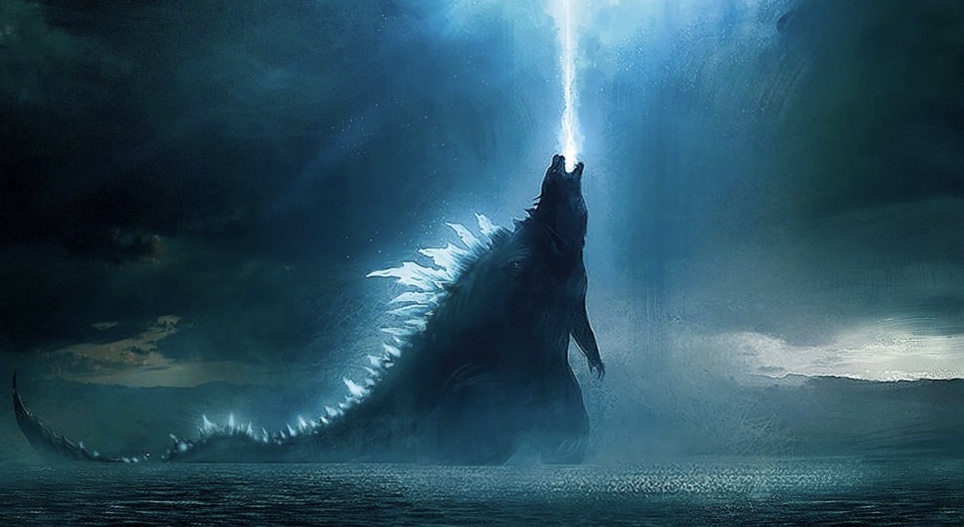Godzilla: Humanity, Spectacle, or Religion?
Godzilla!
 Ed. Note: Warning: This column contains major spoilers for Godzilla: King of the Monsters.
Ed. Note: Warning: This column contains major spoilers for Godzilla: King of the Monsters.
Godzilla: King of the Monsters (2019) is the latest American cinematic addition to the Godzilla movie series, an international multimedia franchise owned by the Japanese company Toho Co., Ltd. It stars the title character Godzilla, a prehistoric sea monster whose destruction of cities was originally conceived as a social commentary on the lingering danger that nuclear weapons posed to Japan in a post-Hiroshima/Nagasaki world.
A sequel to Gareth Edwards’ critically well-received Godzilla (2014), Michael Dougherty’s Godzilla: King of the Monsters has been universally panned. Critics complained that the film lacked sympathetic characters, a strong plot, and a worthwhile emotional payoff. Others criticized the film for spending too much time following the human characters, thereby failing to deliver on the titan-rumble spectacle trailers promised. How to fix this human-monster plotline tension has been a point of debate among critics: why wasn’t there a more developed human story vs. why did the human story constantly distract from the spectacle of monsters fighting on screen?
Beyond these two views, however, there is another possibility: instead of choosing between monster and human, the film actually intends to explore the relationship created between them. On this score, Godzilla: King of the Monsters strikes a notably religious tone. Its characters become religious witnesses to the presence of mythic beings as the film delves into the various ways humanity copes with the reality of coexistence with immanent deities.
The film achieves this in two parts: the first is through sheer technical advancement in the film’s depiction of "realistic" monsters, and the second comes through the proliferation of religious imagery throughout the film.
One of the difficulties the modern adaption faced was depicting monsters as tall as skyscrapers in the modern world. Computer-generated imagery (CGI) makes this possible by first grafting skyscraper-sized titans onto a familiar urban landscape such as Sacramento or Boston, so as to invoke a sense of realism for audiences: what appears on screen is what one imagines it would look like if these monsters trampled on these cities. Second, the monsters’ designs took inspiration from actual animals: the reptilian scales of the titans, the mimicking of large animals’ movement across space, and cries grounded in at least somewhat familiar animal sounds. Thirdly, the film artistically depicts the majesty, the terror, the sublime, emotions that these beings engender in humans by announcing their arrivals with terrifying, albeit recognizable, weather anomalies: Ghidora arrives enmeshed in hurricane-like thunderstorms, Godzilla’s size induces tsunami-level waves, Rodan’s flight creates gusts of volcanic smoke, and Mothra’s wings brilliantly glow.
Altogether, these elements establish for the audience the material existence of these monsters in the world of the film. Successful combinations of realism with spectacle make viewers feel like they are just as much a witness of these spectacles as the characters on the screen. And they know this to be true by the very emotions of terror and awe they feel. In other words, these monsters are real to audience members because their emotions confirm what they witness, and as the reviews have demonstrated, the film succeeded on at least this front.
The plot itself centers on Godzilla’s quest to stop his rival, Ghidora, a three-headed dragon who is described as “a hydra, whose storm swallowed both gods and men alike.” The story, however, is told from the vantage point of a human family: anthrozoologist Mark Russell (played by Kyle Chandler), paleobiologist Dr. Emma Russell (played by Vera Farmiga), and their daughter Madison Russell (played by Millie Bobby Brown). Convinced that humanity’s overpopulation, pollution, and wars are destroying the planet, Emma unleashes Ghidora to correct humanity’s errors. In the maelstrom of Godzilla and Ghidora vying for supremacy, however, Mark attempts to reunite with Emma and Madison while trying to guide Monarch, a government organization created to study and contain these monsters, towards aiding Godzilla.
In all these instances, religious symbolism, metaphors, and imagery abound. These “super-species,” as the film scientifically categorizes them, are the historical creatures upon which human myths were constructed. As Monarch scientist Dr. Ilene Chen (played by Ziyi Zhang) remarks, “Myth is our compass … stories about monsters and dragons could help us find the titans and restore our connection to nature.” Attaching a quasi-Eastern religious perspective to these creatures, she contends that the monsters “are sacred, divine creatures who brought wisdom, strength, even redemption.”
 Christian themes, however, take center stage in the film. The coronation of Ghidorah, a three-headed dragon and the antagonist of the film, as the king of the monsters is foregrounded with a Christian crucifix, invoking a different type of trinitarian divinity. Characters refer to Ghidorah as a “false king,” implying that its trinitarian nature is perhaps a foil to the Christian trinity, hinting also at the satanic dragon in the book of Revelation.
Christian themes, however, take center stage in the film. The coronation of Ghidorah, a three-headed dragon and the antagonist of the film, as the king of the monsters is foregrounded with a Christian crucifix, invoking a different type of trinitarian divinity. Characters refer to Ghidorah as a “false king,” implying that its trinitarian nature is perhaps a foil to the Christian trinity, hinting also at the satanic dragon in the book of Revelation.
In one fight with Ghidora, Godzilla nearly dies while in the hands of the military. In an effort to “bring Godzilla back from the dead,” as one soldier remarks, scientist Dr. Ishiro Serizawa (played by Ken Watanabe) sacrifices himself to revive Godzilla. To justify his actions, Serizawa argues that Godzilla “fought for us, died for us. It’s not only proof that co-existence is possible, he is the key to it.” Before his sacrifice, Serizawa bequeaths a notebook containing fieldwork notes to Mark. The text, in its contents about the supernatural beings and its significance to Serizawa, the main apostle of the benevolent beings, is received with scripture-level significance. Godzilla’s resurrection, as a result of the sacrifice, directly threatens the reign of the “false king,” Ghidorah.
Confronted with these otherwise biblical realities, the human characters respond theologically (and director Michael Dougherty even directly compared Godzilla to the Leviathan in the book of Job). Serizawa maintains his faith in the benevolence of Godzilla, relaying to Mark that “there are some things beyond our understanding, Mark. We must accept them and learn from them, because these moments of crisis are also potential moments of faith.” Emma, over the course of the film, loses her skepticism about humanity’s capacity for good, ultimately sacrificing herself to defeat the evil she unleashed. And as Mark’s faith in Godzilla grows, it allows him to finally reunite with his daughter. Salvation and redemption defined the arcs of these characters, and their destinies were ultimately directed by their evolving relationships with Godzilla. Thus, the journeys of these characters (both human and monster) were thoroughly religious ones.
The film also makes clear that religion manifests precisely because the relationship between human and titan is asymmetric: both grapple with the reality that the other exists, even while one more fully bears the consequences of the other’s benevolence or tyranny. And it is within this asymmetry that the aforementioned human theologies are constructed. This dynamic, however, assumes the reality of the monsters for both the characters and for moviegoers alike. Monsters become real through the spectacles that the characters and viewers witness. These visual and aural cues engender feelings of awe, terror, and the sublime, in a manner that makes audience members witnesses to something they feel as "real." Perhaps to take religion seriously in a movie like Godzilla is to acknowledge the role of spectacles in upholding the asymmetric relationship between humanity and the reality of titans, and to explore the theologies constructed within those relationships. And on this front, the film definitely succeeds.
Images (in order): Godzilla (Photo courtesy of Godzilla: King of the Monsters); Mothra (Photo courtesy of Godzilla: King of the Monsters); Ghidorah (Photo courtesy of Godzilla: King of the Monsters).
| Author, Michael Baysa, is a PhD student at Princeton University’s Department of Religion in their Religion in the Americas subfield. His research focuses on the rise of theologically liberal networks in late eighteenth-century New England. He can be found on Twitter (@MichaelBaysa) or LinkedIn. |
Sightings is edited by Joel Brown, a PhD Candidate in Religions in America at the Divinity School. Sign up here to receive Sightings via email. Y


